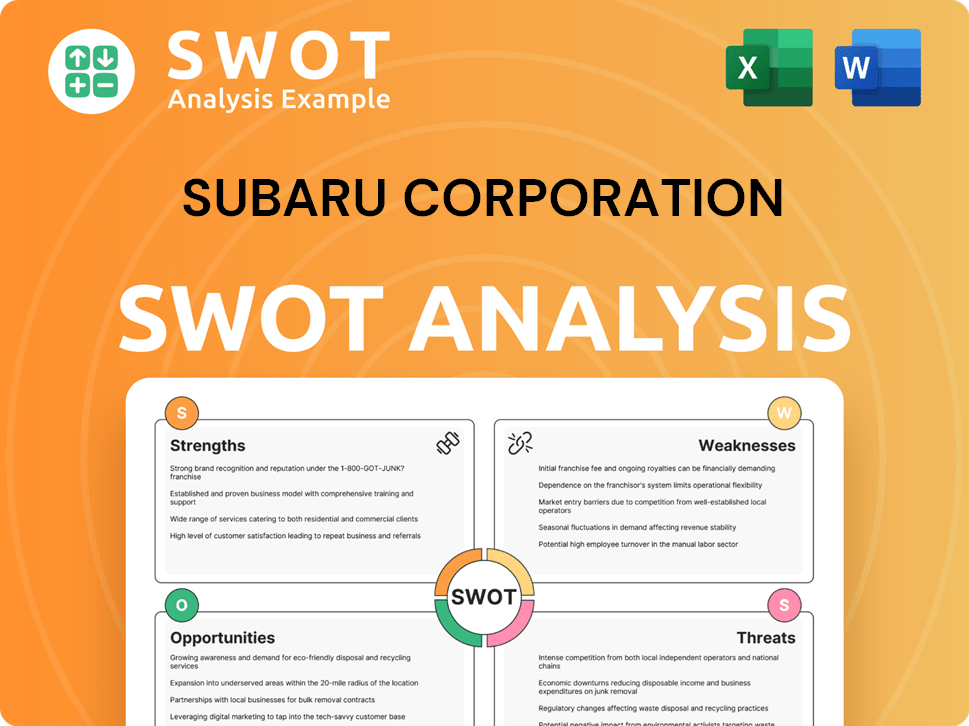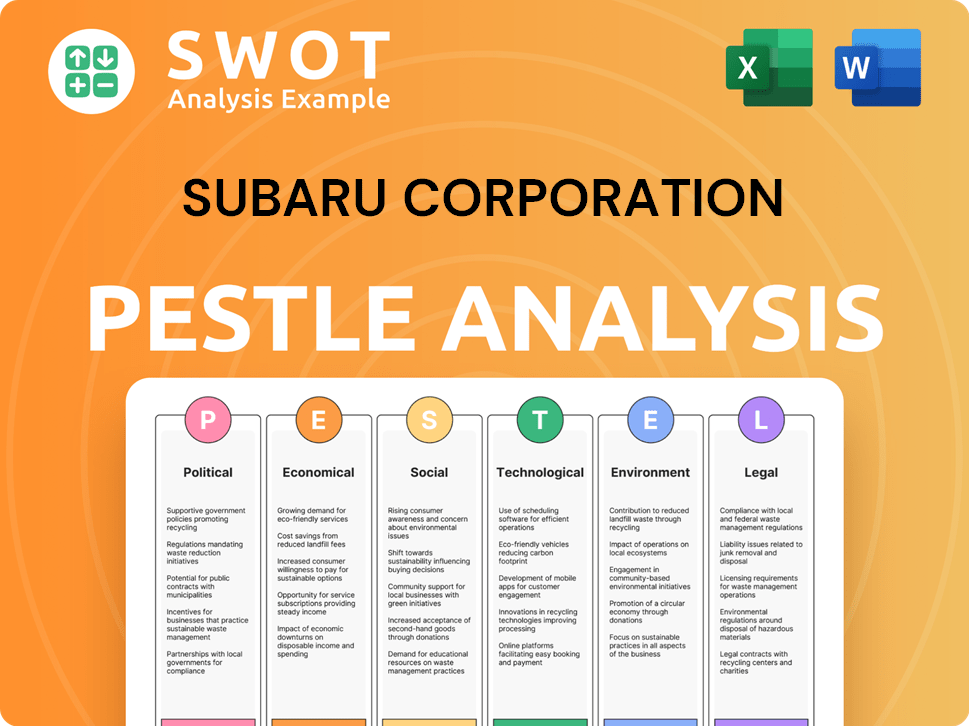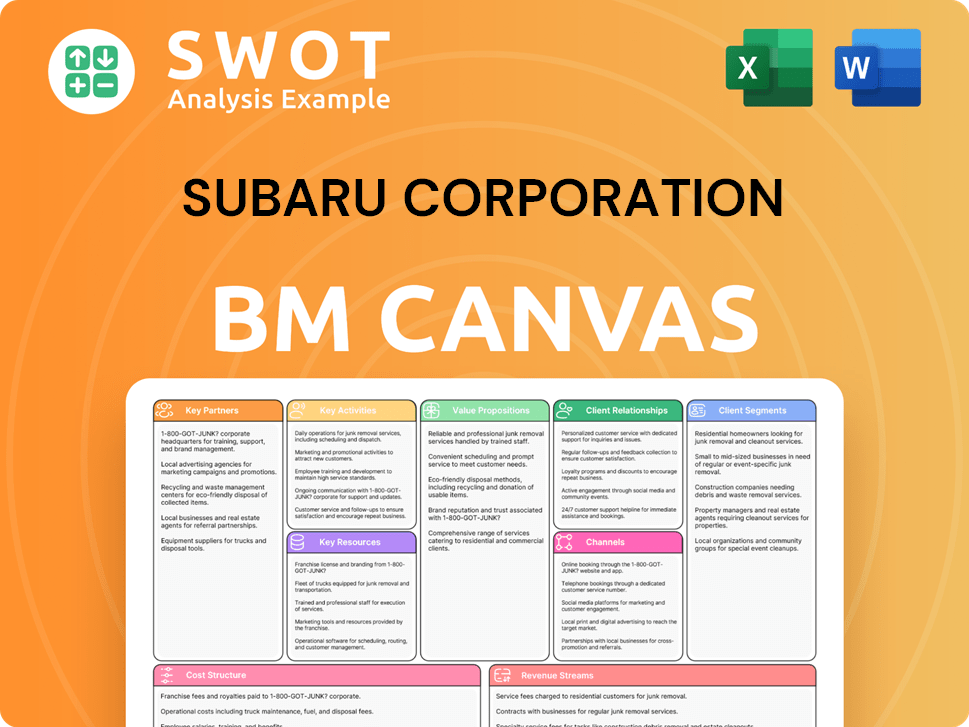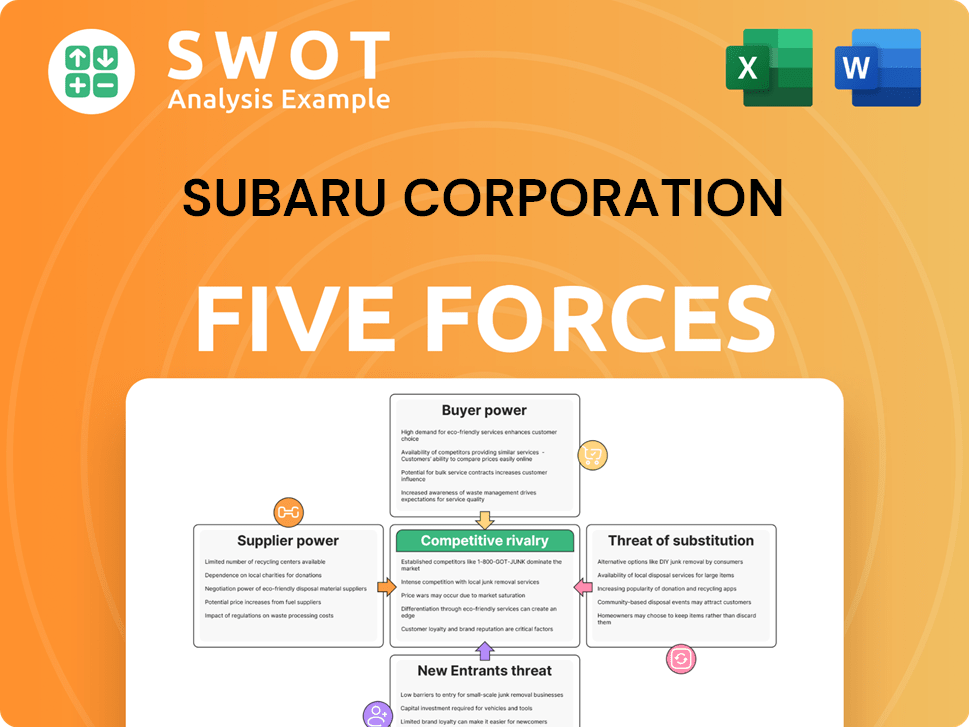Subaru Corporation Bundle
How Does Subaru Corporation Drive Success?
Subaru Corporation, a Japanese automotive icon, stands out with its unique engineering and unwavering commitment to all-wheel drive. But how does this company, known for its boxer engines and rugged vehicles, actually operate and thrive in the competitive global market? Understanding the inner workings of Subaru Corporation SWOT Analysis is key to appreciating its enduring appeal and financial performance.

This exploration into How Subaru Works will uncover the core of Subaru's operations, from its distinctive Subaru Manufacturing processes to its strategic business model. We'll examine Subaru's global presence and financial performance, providing insights for investors, customers, and industry analysts alike. Discover the secrets behind Subaru's success, its innovative designs, and its plans for the future, all while navigating the complexities of the automotive industry.
What Are the Key Operations Driving Subaru Corporation’s Success?
Subaru Corporation's core operations encompass the design, manufacturing, and sale of Subaru vehicles, along with contributions to the aerospace and industrial products sectors. The company's approach is distinguished by its engineering choices, particularly its Symmetrical All-Wheel Drive system and horizontally opposed boxer engine. These features provide a lower center of gravity, enhancing stability and traction, which appeals to customers who prioritize safety and a unique driving experience.
Key vehicle models like the Forester, Outback, Crosstrek, and Ascent target the SUV and crossover markets, while the Impreza and Legacy serve the sedan segment, and the WRX caters to performance enthusiasts. Operational processes involve a highly integrated supply chain, sophisticated assembly lines, and a global distribution network. Customer service is managed through its dealer network, offering maintenance, repairs, and parts.
What sets Subaru apart is its commitment to its signature powertrain and AWD system, which differentiates it from many competitors. This specialization translates into customer benefits such as enhanced safety in adverse conditions and improved handling, fostering strong brand loyalty. For more insights into the company's strategic direction, consider exploring the Growth Strategy of Subaru Corporation.
Subaru's core operations focus on vehicle design, manufacturing, and sales, with a strong emphasis on its unique engineering features. The company also participates in the aerospace and industrial products sectors. The company's manufacturing is primarily based in Japan and the United States, ensuring quality control and efficient production.
The value proposition centers on safety, performance, and a distinctive driving experience, driven by its Symmetrical All-Wheel Drive and boxer engine. Key models such as the Forester, Outback, and Crosstrek cater to the SUV and crossover markets. Subaru's focus on these features builds strong brand loyalty among customers.
Subaru's operations are characterized by a vertically integrated supply chain and sophisticated manufacturing processes. The Gunma Plant in Japan and Subaru of Indiana Automotive (SIA) in the U.S. are critical to its production capacity. The company's distribution network is global, supported by robust logistics and a dealer network for customer service.
- Manufacturing Capacity: SIA in the U.S. produced over 300,000 vehicles in 2024.
- Global Sales: Subaru's global sales reached approximately 600,000 units in the fiscal year 2024.
- Market Share: Subaru holds a significant market share in the all-wheel-drive vehicle segment, with approximately 20% in key markets.
- R&D Investment: The company invests around 5% of its revenue in research and development annually.
Subaru Corporation SWOT Analysis
- Complete SWOT Breakdown
- Fully Customizable
- Editable in Excel & Word
- Professional Formatting
- Investor-Ready Format

How Does Subaru Corporation Make Money?
The core of Subaru Corporation's financial strategy revolves around its revenue streams and how it monetizes its products and services. The primary source of income stems from the sale of automobiles and related automotive components. This is the backbone of the company's financial performance, consistently accounting for the majority of its total revenue.
In the fiscal year ending March 31, 2024, automotive sales were the dominant contributor to the company's overall revenue. This dominance underscores the importance of vehicle sales in driving the company's financial health. The company's ability to generate income from vehicle sales is critical to sustaining its operations and investing in future growth.
Beyond the sale of new vehicles, the company has other revenue streams. These include the sale of parts and accessories, after-sales services, and financial services associated with vehicle purchases. While these streams are smaller compared to new vehicle sales, they are still important. They contribute to customer retention and provide recurring income, which helps stabilize the company's financial performance.
In fiscal year 2024, Subaru reported net sales of 4,681.3 billion yen (approximately $30.2 billion USD). This figure highlights the substantial impact of its automotive sales across key markets.
The sale of parts and accessories adds to the revenue. These items are important for maintaining vehicles and enhancing the customer experience.
After-sales services, such as maintenance and repairs, provide a steady income stream. These services help build customer loyalty and ensure vehicles remain in good condition.
Financial services, including financing and leasing options, support vehicle sales. These services make it easier for customers to purchase vehicles.
Revenue is also generated from aerospace and industrial products. However, these sectors contribute a smaller percentage compared to automotive sales.
The company uses premium pricing for its AWD vehicles. Bundled services, such as extended warranties, also contribute to customer lifetime value.
The company's monetization strategies are centered on premium pricing for its AWD-equipped vehicles, capitalizing on its reputation for safety and durability. Furthermore, bundled services, like extended warranties and service packages, boost customer lifetime value. These strategies help the company maximize revenue from each customer relationship, supporting its long-term financial goals. The company's focus on these strategies reflects its commitment to providing high-quality vehicles and services, ensuring sustained profitability and growth within the competitive automotive market.
Subaru Corporation PESTLE Analysis
- Covers All 6 PESTLE Categories
- No Research Needed – Save Hours of Work
- Built by Experts, Trusted by Consultants
- Instant Download, Ready to Use
- 100% Editable, Fully Customizable

Which Strategic Decisions Have Shaped Subaru Corporation’s Business Model?
The evolution of Subaru Corporation has been marked by significant milestones and strategic decisions. A core element of its identity has been the persistent development and refinement of its Symmetrical All-Wheel Drive system and boxer engine. These technological innovations have set Subaru apart, fostering a strong brand identity centered on safety and reliability. Early strategic moves, such as expanding into the North American market, have been pivotal in establishing its global presence.
Subaru's operational strategies have adapted to global challenges, including supply chain disruptions and economic fluctuations. The company has focused on optimizing production schedules and diversifying sourcing to mitigate risks. Despite these challenges, Subaru has demonstrated resilience, as evidenced by its global vehicle sales figures. The company's ability to adapt to market demands and operational hurdles showcases its strategic agility.
Subaru's competitive advantage is rooted in its unique technology and strong brand image. The company's focused product lineup allows for greater specialization and efficiency in manufacturing. Subaru continues to invest in electrification and advanced driver-assistance systems (ADAS) to stay competitive in the evolving automotive industry. This proactive approach ensures that Subaru remains relevant and responsive to the changing needs of its customers and the broader market trends.
The introduction of the Symmetrical All-Wheel Drive system and boxer engine has been a cornerstone of the company's identity. Expansion into the North American market was a crucial strategic move, establishing a significant sales region. The establishment of Subaru of Indiana Automotive (SIA) enhanced production capabilities.
Subaru has focused on optimizing production and diversifying sourcing to manage supply chain disruptions. Investing in electrification, with models like the Solterra EV, demonstrates a commitment to future trends. Enhancing advanced driver-assistance systems (ADAS) like EyeSight is another key strategic move.
Subaru's strong brand identity, centered on safety and reliability, is a key differentiator. Its unique AWD and boxer engine technology create a distinct driving experience, fostering customer loyalty. A relatively focused product lineup allows for greater manufacturing efficiency.
In the fiscal year ended March 31, 2024, Subaru's global vehicle sales reached 1,029,000 units, demonstrating resilience. The company continues to adapt to market demands and operational hurdles. Subaru's financial performance reflects its strategic agility and market responsiveness.
Subaru's ability to navigate supply chain issues and adapt to market changes highlights its strategic prowess. The company's focus on electrification and advanced driver-assistance systems (ADAS) positions it well for future growth. Understanding the Target Market of Subaru Corporation is crucial for sustained success.
- Investment in electric vehicles, such as the Solterra, to meet growing demand.
- Enhancements to ADAS, including EyeSight, to improve safety features.
- Continued focus on the North American market, its largest sales region.
- Strategic partnerships to leverage technology and expand market reach.
Subaru Corporation Business Model Canvas
- Complete 9-Block Business Model Canvas
- Effortlessly Communicate Your Business Strategy
- Investor-Ready BMC Format
- 100% Editable and Customizable
- Clear and Structured Layout

How Is Subaru Corporation Positioning Itself for Continued Success?
Subaru Corporation, a prominent player in the automotive industry, holds a distinctive market position. The company, known for its all-wheel-drive vehicles and boxer engines, has cultivated a loyal customer base, particularly in North America. While not as large as some global competitors, Subaru Company maintains a strong brand image centered on safety, reliability, and performance.
However, Subaru faces several challenges. Intense competition, evolving regulations, and technological disruptions pose significant risks. The shift towards electric vehicles (EVs) and autonomous driving necessitates substantial investment and strategic adaptation to maintain its market share. Supply chain vulnerabilities, as experienced during the semiconductor shortage, also present ongoing concerns.
Subaru Corporation is a niche player with a strong brand reputation, especially in North America. It competes with larger automakers such as Toyota and Volkswagen. The company's focus on safety, reliability, and all-wheel-drive systems has created a dedicated customer base.
Key risks include intense competition, regulatory changes, and technological disruptions. The shift to EVs and autonomous driving requires significant investment. Supply chain issues, like semiconductor shortages, also pose a threat to production and sales.
Subaru is focusing on electrification, enhanced safety, and sustainable manufacturing. The company aims to expand its EV lineup and integrate advanced driver-assistance technologies. Leadership is committed to carbon neutrality.
Subaru plans to differentiate its products through core technologies and invest in new technologies. The company is optimizing its global production and sales network. The company is targeting global sales of 1.2 million vehicles by the fiscal year ending March 2026.
Subaru Corporation is actively working on several key areas to secure its future. These include expanding its electric vehicle offerings and incorporating advanced safety features. The company is also committed to sustainable manufacturing practices and aims for carbon neutrality.
- Electrification of the vehicle lineup.
- Enhancement of advanced driver-assistance systems.
- Expansion of global production and sales networks.
- Investment in research and development for new technologies.
For more insights, consider reading about the Growth Strategy of Subaru Corporation. As of 2024, Subaru Manufacturing is increasing its focus on EV production to meet growing market demand. Subaru Operations are being streamlined to improve efficiency. The Subaru Business Model continues to emphasize its core strengths while adapting to the changing automotive landscape.
Subaru Corporation Porter's Five Forces Analysis
- Covers All 5 Competitive Forces in Detail
- Structured for Consultants, Students, and Founders
- 100% Editable in Microsoft Word & Excel
- Instant Digital Download – Use Immediately
- Compatible with Mac & PC – Fully Unlocked

Related Blogs
- What are Mission Vision & Core Values of Subaru Corporation Company?
- What is Competitive Landscape of Subaru Corporation Company?
- What is Growth Strategy and Future Prospects of Subaru Corporation Company?
- What is Sales and Marketing Strategy of Subaru Corporation Company?
- What is Brief History of Subaru Corporation Company?
- Who Owns Subaru Corporation Company?
- What is Customer Demographics and Target Market of Subaru Corporation Company?
Disclaimer
All information, articles, and product details provided on this website are for general informational and educational purposes only. We do not claim any ownership over, nor do we intend to infringe upon, any trademarks, copyrights, logos, brand names, or other intellectual property mentioned or depicted on this site. Such intellectual property remains the property of its respective owners, and any references here are made solely for identification or informational purposes, without implying any affiliation, endorsement, or partnership.
We make no representations or warranties, express or implied, regarding the accuracy, completeness, or suitability of any content or products presented. Nothing on this website should be construed as legal, tax, investment, financial, medical, or other professional advice. In addition, no part of this site—including articles or product references—constitutes a solicitation, recommendation, endorsement, advertisement, or offer to buy or sell any securities, franchises, or other financial instruments, particularly in jurisdictions where such activity would be unlawful.
All content is of a general nature and may not address the specific circumstances of any individual or entity. It is not a substitute for professional advice or services. Any actions you take based on the information provided here are strictly at your own risk. You accept full responsibility for any decisions or outcomes arising from your use of this website and agree to release us from any liability in connection with your use of, or reliance upon, the content or products found herein.